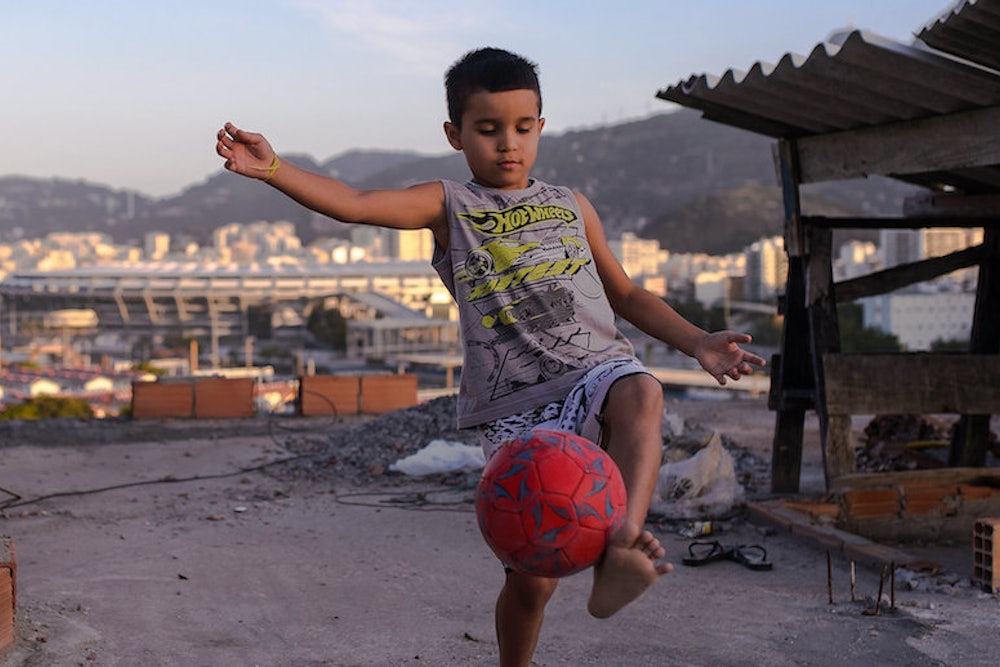The developing world has provided 90 percent of worldwide urban population growth recently, and in 2008 made human beings majority-urbanite for the first time in history. You could perhaps find no better emblem of this trend than Brazil. Well before plans to host the 2014 World Cup Finals and 2016 Summer Olympics got underway, Brazil (as I’ve previously noted) went from a country that, in 1940, had two non-urban dwellers for every urban one to a country that, as of 2010, has an 87 percent urban population. This was in no small part the product of government policies of moving masses of people to the cities and having them build their own neighborhoods. This created unprecedented wealth and prosperity overall—Brazil is now the world’s fifth-largest economy. It also gave rise to stark inequality and mass poverty, including the world-famous favelas, the unlicensed shanty towns on the outskirts of the cities.
Now that Brazil is getting set to host not one but two major international prestige sporting events, the urbanization is getting more intense, introducing more instability into an already chaotic socioeconomic system. Such development helped prompt this past summer’s protests, which were directed in part at the massive sums Brazil’s government is spending to build new soccer stadiums. Recently, Rio de Janeiro has been subjected to an epidemic of beach robberies seen as a response to the police’s stepped up gang raids in the run-up to the World Cup. The northeastern city of Salvador has experienced gigantic economic strides, a high-culture renaissance—and the highest homicide rate in Brazil.
And today, New York Times architecture critic Michael Kimmelman takes stock of how Rio’s $4 billion port redevelopment plan is “modernizing” run-down neighborhoods, razing old warehouses, and demolishing homes, replacing them with commercial real estate, an arts center, and, of course, the Olympic Village. An accompanying photo essay (itself well worth your time) shows a newly built cable-car system flying through the air over a favela—a particularly obvious symbol of what is going on here.
“Rio’s mayor, Eduardo Paes, is saying all the right things about combating sprawl, beefing up mass transit, constructing new schools, and pacifying and integrating the favelas, where one in five city residents lives, with the rest of the city,” reports Kimmelman. “But as months of street protests illustrate, progressive ideals run up against age-old, intractable problems in this city where class difference and corruption are nearly as immovable as the mountains.”
In his landmark book All That Is Solid Melts Into Air, the recently deceased Marshall Berman called these processes “the tragedy of development.” Development, even when imposed from above under neoliberal auspices, can be a progressive force for everyone, Berman argued; but it is never without tragedy. He writes movingly of the south Bronx neighborhoods of his own childhood that Robert Moses demolished to make way for the Cross-Bronx Expressway. One result of the CBE was to traumatize Berman. Another was to make it easier to drive from New Jersey to Connecticut. Yet another was to touch off a horrific wave of arson, blight, and crime. And yet another result—as Berman never forgot—was to help spawn an entirely new culture, which, in the case of the south Bronx, gave the world hip-hop.
“We come from ruins, but we’re not ruined,” Berman says (in this wonderful video clip) of the Bronx kids in the 1970s who painted gorgeous graffiti on subway cars and created a new, extremely influential type of music. His goal wasn’t to justify or redeem Moses, entirely; it was to explain an inescapable historic process. It seems obvious that Rio, Salvador, and other cities in Brazil and throughout the developing world are the Bronxes of today. What terrors have they yet to unleash, and what new forms of creativity will they birth? How soon until baile funk, a kind of dance music already popular in Brazil that comes directly from the criminal gangs of Rio’s favelas, becomes a worldwide sensation?
